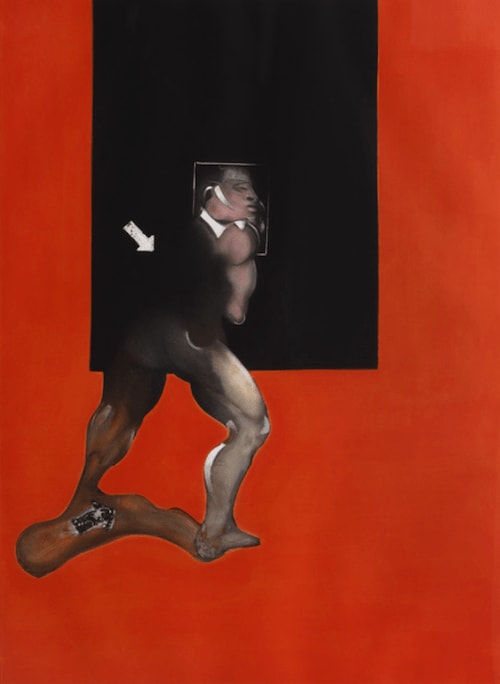
Francis Bacon
163 x 121 cm
Francis Bacon’s After Study from the Human Body is a powerful embodiment of the artist’s radical reimagining of the human figure—an image defined not by anatomical precision, but by distortion, fragmentation, and existential exposure. As with much of Bacon’s work, this piece reflects his relentless interrogation of the body as a vessel of vulnerability, a site where physical form collides with psychological unrest. In this print, Bacon intensifies the viewer’s experience of bodily disintegration and inner tension, situating the figure in a stark, abstracted space that denies comfort or familiarity.
The central figure in After Study from the Human Body is twisted and deformed, its proportions stretched and distorted to the point of abstraction. Most notably, the legs—contorted and exaggerated—seem to fuse with the ground beneath them, blurring the boundary between flesh and floor. This gesture renders the body unstable, neither fully upright nor grounded, and evokes a powerful sense of dislocation. The figure appears trapped in a state of metamorphosis, as though it is being absorbed by its surroundings, or melting into the very surface upon which it stands. Bacon’s figures are rarely static; they pulse with tension, caught mid-motion in some unseen struggle, often embodying a liminal space between coherence and collapse.
This sense of entrapment is reinforced by the composition’s striking visual architecture. A bold, flat expanse of orange dominates the background, engulfing the scene in an unnatural, emotionally charged atmosphere. The orange is both vibrant and unsettling—a color that does not soothe but sears, functioning almost like a psychological heat map. Against this backdrop, the figure is rendered in dark, bruised tones, further isolating it within the frame. A black rectangle—functioning as a spatial enclosure or framing device—surrounds the body, heightening the claustrophobic effect. It is as though the figure is boxed in by its own existence, symbolically confined within the limits of flesh, mortality, and self-awareness.
Bacon’s refusal to place his subjects in recognisable, grounded environments is central to his strategy. The space in this work is not realistic, but existential. There is no horizon, no depth, no relief—only flatness and void. The environment acts as a psychological pressure chamber, directing all attention to the battered form at its center. The body is not heroic, idealised, or even whole. It is raw and ruptured, its deformation speaking as much to inner turmoil as to physical instability.
More than anatomical representations, Bacon’s figures are psychological portraits. The distortions he applies to the body are metaphors for emotional rupture—for the tension between interior experience and external form. In After Study from the Human Body, the figure’s posture, ambiguity, and almost animalistic form evoke a state of crisis—perhaps anguish, perhaps defeat. There is no face to read, no identity to anchor; the figure is depersonalized, universalized. It becomes an archetype of existential fragility, representing the human being stripped of social veneer and exposed to the raw conditions of existence.
The emotional impact of the work is heightened by its minimalism. With so little visual information—no narrative cues, no landscape, no symbolic props—every compositional element becomes charged with meaning. The enclosure, the aggressive color, the ambiguous anatomy—all work together to create a space where the viewer is forced to confront not only the fragility of the body but the instability of identity itself. Bacon’s refusal to offer resolution or coherence mirrors the dissonance of modern life, where meaning is elusive and the self is fragmented.
At its core, After Study from the Human Body is a meditation on the violence of being—the tension between the physical shell and the chaotic interior, between visibility and erasure. It is a continuation of Bacon’s broader philosophical engagement with the works of existentialist thinkers such as Nietzsche, Sartre, and Beckett, whose writings explored the absurdity of existence, the void of meaning, and the disintegrating structures of identity. Bacon does not offer solace; he offers truth—distorted, unvarnished, and hauntingly immediate.
In this work, as in much of his output, Bacon redefines what it means to depict the human form. He moves beyond the body as a physical object and into the body as an emotional and psychological condition. After Study from the Human Body is not just a study in flesh, but a study in being—where the form is both presence and disappearance, resilience and collapse, exposure and entrapment. It is a testament to Bacon’s unique ability to express the inexpressible, to make visible the invisible fractures of human experience.
For more information on Francis Bacon’s After Study from the Human Body or to buy Francis Bacon’s After Study from the Human Body contact our galleries using the form below.